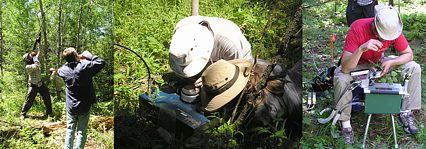
Collaborative research: Restricted
plasticity of canopy stomatal conductance: Conceptual basis for
simplified models of canopy transpiration.
Funding Source: National Science Foundation,
Directorate for Geosciences, Hydrological Sciences Division
Dates: April 1, 2004 to March 31, 2008.
Project Director: D. Scott Mackay
Co-Investigators: Brent E. Ewers (U. Wyoming),
Eric L. Kruger (U. Wisconsin)
Summary:
This project seeks a conceptual model of forest transpiration
that embraces the spatial variability of stomatal control while
retaining a tractable measure of generality that is the hallmark
of empirical models of stomatal conductance. The conceptual model
is based on the idea that canopy stomatal conductance is regulated
primarily by water potential when water fluxes are high and of
significant hydrologic import. It is hypothesized here that species
plasticity in canopy stomatal conductance, which determines its
spatial variability and challenge for quantifying, follows a linear
relationship keyed to an easily quantifiable reference conductance.
The knowledge gained from this research has broad implications
for land surface modeling efforts directed at global change effects
on water cycling. It will provide a relatively simple, but transportable
and scientifically defensible, canopy model. Such models are essential
foundations for the creation and implementation of credible policies
aimed at mitigating or adjusting to the consequences of anticipated
global change.
NSF Discoveries - Taking the Pulse of the Forest
LiveScience
Article: Taking the Pulse of the Forest
Project Activities & Findings:
--> Click here
for the detailed report
--> Click here
for the graphics
--> Click here
for a list of data products
Publications:
Samanta, S., M.K. Clayton, D.S. Mackay, E.L. Kruger, and B.E.
Ewers. 2008. Quantitative comparison of canopy conductance models
using a Bayesian approach. Water Resources Research, in press.
Adelman, J.D.,
B.E. Ewers, and D.S. Mackay. 2008. Using temporal patterns in
vapor pressure deficit to explain spatial autocorrelation dynamics
in tree transpiration. Tree Physiology, 28, 657-658.
[ please email for a pdf ]
Loranty,
M.M., D.S. Mackay, B.E. Ewers, J.D. Adelman, and E.L. Kruger.
2008. Environmental drivers of spatial variation in whole-tree
transpiration in an aspen-dominated upland-to-wetland forest gradient.
Water Resources Research, 44, W02441, doi:10.1029/2007WR006272.
[ please email for a pdf ]
Ewers, B.E., D.S. Mackay, J. Tang, P. Bolstad, and S. Samanta.
2008. Intercomparison of Sugar Maple (Acer saccharum Marsh.)
stand transpiration responses to environmental conditions from
the Western Great Lakes Region of the United State. Agricultural
and Forest Meteorology, doi:10.1016/j.agrformet.2007.08.003,
148, 231-246. [ please email for a pdf ]
Samanta,
S., D.S. Mackay, M. Clayton, E.L. Kruger, and B.E. Ewers. 2007.
Bayesian analysis for uncertainty estimation of a canopy transpiration
model. Water Resources Research, 43, W04424, doi:10.1029/2006WR005028.
[ download
]
Mackay, D.S.,
B.E. Ewers, B.D. Cook, and K.J. Davis. 2007. Environmental drivers
of evapotranspiration in a shrub wetland and an upland forest
in northern Wisconsin, Water Resour. Res., 43, W03442, doi:10.1029/2006WR005149.
[ download
]
Software Products (TBA)
Project Implications:
--> Click here
for the detailed report


